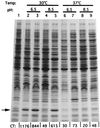Cyclic AMP and its receptor protein negatively regulate the coordinate expression of cholera toxin and toxin-coregulated pilus in Vibrio cholerae
- PMID: 8990197
- PMCID: PMC19310
- DOI: 10.1073/pnas.94.1.265
Cyclic AMP and its receptor protein negatively regulate the coordinate expression of cholera toxin and toxin-coregulated pilus in Vibrio cholerae
Abstract
Insertion mutations in two Vibrio cholerae genes, cya and crp, which encode adenylate cyclase and the cyclic AMP (cAMP) receptor protein (CRP), respectively, derepressed the expression of a chromosomal cholera toxin (CT) promoter-lacZ fusion at the nonpermissive temperature of 37 degrees C. In the classical biotype strain O395, the crp mutation increased the production of both CT and toxin-coregulated pilus (TCP) in vitro under a variety of growth conditions not normally permissive for their expression. The most dramatic increase in CT and TCP was observed with the crp mutant in Luria-Bertani (LB) medium pH 8.5, at 30 degrees C. El Tor biotype strains differ from classical strains in that they do not produce CT or TCP when grown in LB media. Incorporation of the crp mutation into El Tor strain C6706 permitted production of these proteins in LB medium pH 6.5, at 30 degrees C. In the infant mouse cholera model, the crp mutation decreased colonization in both biotypes at least 100-fold relative to the wild-type strains. The data presented here suggest a model whereby cAMP-CRP negatively regulates the expression of CT and TCP in both classical and El Tor biotypes under certain environmental conditions and also influences pathogenesis by regulating other processes necessary for optimal growth in vivo.
Figures





Similar articles
-
Suppression of Virulence of Toxigenic Vibrio cholerae by Anethole through the Cyclic AMP (cAMP)-cAMP Receptor Protein Signaling System.PLoS One. 2015 Sep 11;10(9):e0137529. doi: 10.1371/journal.pone.0137529. eCollection 2015. PLoS One. 2015. PMID: 26361388 Free PMC article.
-
Analysis of an autoregulatory loop controlling ToxT, cholera toxin, and toxin-coregulated pilus production in Vibrio cholerae.J Bacteriol. 1999 Apr;181(8):2584-92. doi: 10.1128/JB.181.8.2584-2592.1999. J Bacteriol. 1999. PMID: 10198025 Free PMC article.
-
Differential expression of the ToxR regulon in classical and E1 Tor biotypes of Vibrio cholerae is due to biotype-specific control over toxT expression.Proc Natl Acad Sci U S A. 1996 Jul 23;93(15):7991-5. doi: 10.1073/pnas.93.15.7991. Proc Natl Acad Sci U S A. 1996. PMID: 8755590 Free PMC article.
-
Regulation of virulence in Vibrio cholerae.Int J Med Microbiol. 2001 May;291(2):81-8. doi: 10.1078/1438-4221-00104. Int J Med Microbiol. 2001. PMID: 11437342 Review.
-
Pathogenic and vaccine significance of toxin-coregulated pili of Vibrio cholerae E1 Tor.J Biotechnol. 1999 Aug 20;73(2-3):109-17. doi: 10.1016/s0168-1656(99)00114-5. J Biotechnol. 1999. PMID: 10486921 Review.
Cited by
-
A highly specific cell-based high-throughput screening assay for ligands of cyclic adenosine monophosphate receptor protein in gram-negative bacteria.Assay Drug Dev Technol. 2013 Jul;11(6):382-7. doi: 10.1089/adt.2013.514. Epub 2013 Aug 1. Assay Drug Dev Technol. 2013. PMID: 23906348 Free PMC article.
-
Environmental signals controlling production of hemagglutinin/protease in Vibrio cholerae.Infect Immun. 2001 Oct;69(10):6549-53. doi: 10.1128/IAI.69.10.6549-6553.2001. Infect Immun. 2001. PMID: 11553605 Free PMC article.
-
The ToxR-mediated organic acid tolerance response of Vibrio cholerae requires OmpU.J Bacteriol. 2001 May;183(9):2746-54. doi: 10.1128/JB.183.9.2746-2754.2001. J Bacteriol. 2001. PMID: 11292792 Free PMC article.
-
The cyclic AMP-dependent catabolite repression system of Serratia marcescens mediates biofilm formation through regulation of type 1 fimbriae.Appl Environ Microbiol. 2008 Jun;74(11):3461-70. doi: 10.1128/AEM.02733-07. Epub 2008 Apr 18. Appl Environ Microbiol. 2008. PMID: 18424546 Free PMC article.
-
Heat-labile enterotoxin promotes Escherichia coli adherence to intestinal epithelial cells.J Bacteriol. 2009 Jan;191(1):178-86. doi: 10.1128/JB.00822-08. Epub 2008 Oct 31. J Bacteriol. 2009. PMID: 18978047 Free PMC article.
References
Publication types
MeSH terms
Substances
Associated data
- Actions
Grants and funding
LinkOut - more resources
Full Text Sources
Other Literature Sources
Research Materials
Miscellaneous

